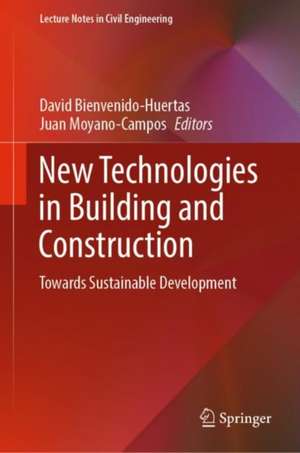New Technologies in Building and Construction: Towards Sustainable Development: Lecture Notes in Civil Engineering, cartea 258
Editat de David Bienvenido-Huertas, Juan Moyano-Camposen Limba Engleză Hardback – 16 mai 2022
| Toate formatele și edițiile | Preț | Express |
|---|---|---|
| Paperback (1) | 704.36 lei 6-8 săpt. | |
| Springer Nature Singapore – 17 mai 2023 | 704.36 lei 6-8 săpt. | |
| Hardback (1) | 961.55 lei 3-5 săpt. | |
| Springer Nature Singapore – 16 mai 2022 | 961.55 lei 3-5 săpt. |
Din seria Lecture Notes in Civil Engineering
- 18%
 Preț: 1232.26 lei
Preț: 1232.26 lei - 18%
 Preț: 1389.30 lei
Preț: 1389.30 lei - 18%
 Preț: 950.52 lei
Preț: 950.52 lei - 18%
 Preț: 1003.38 lei
Preț: 1003.38 lei - 18%
 Preț: 1401.93 lei
Preț: 1401.93 lei - 18%
 Preț: 1870.73 lei
Preț: 1870.73 lei - 18%
 Preț: 956.81 lei
Preț: 956.81 lei - 23%
 Preț: 586.52 lei
Preț: 586.52 lei - 24%
 Preț: 1192.24 lei
Preț: 1192.24 lei - 18%
 Preț: 950.52 lei
Preț: 950.52 lei - 18%
 Preț: 1565.29 lei
Preț: 1565.29 lei - 18%
 Preț: 1219.63 lei
Preț: 1219.63 lei - 18%
 Preț: 950.52 lei
Preț: 950.52 lei - 18%
 Preț: 1408.26 lei
Preț: 1408.26 lei - 18%
 Preț: 1579.49 lei
Preț: 1579.49 lei - 18%
 Preț: 1551.27 lei
Preț: 1551.27 lei - 18%
 Preț: 1392.46 lei
Preț: 1392.46 lei - 20%
 Preț: 1560.60 lei
Preț: 1560.60 lei - 18%
 Preț: 3692.22 lei
Preț: 3692.22 lei - 18%
 Preț: 1390.89 lei
Preț: 1390.89 lei - 24%
 Preț: 2401.73 lei
Preț: 2401.73 lei - 18%
 Preț: 2109.85 lei
Preț: 2109.85 lei - 18%
 Preț: 2577.86 lei
Preț: 2577.86 lei - 18%
 Preț: 1383.00 lei
Preț: 1383.00 lei - 18%
 Preț: 1566.90 lei
Preț: 1566.90 lei - 18%
 Preț: 2544.69 lei
Preț: 2544.69 lei - 18%
 Preț: 1397.82 lei
Preț: 1397.82 lei - 18%
 Preț: 1902.30 lei
Preț: 1902.30 lei - 18%
 Preț: 1843.11 lei
Preț: 1843.11 lei - 18%
 Preț: 1228.62 lei
Preț: 1228.62 lei - 18%
 Preț: 1000.20 lei
Preț: 1000.20 lei - 18%
 Preț: 1581.10 lei
Preț: 1581.10 lei - 18%
 Preț: 2163.50 lei
Preț: 2163.50 lei - 24%
 Preț: 1462.51 lei
Preț: 1462.51 lei - 18%
 Preț: 2140.65 lei
Preț: 2140.65 lei - 18%
 Preț: 1008.11 lei
Preț: 1008.11 lei - 18%
 Preț: 2131.95 lei
Preț: 2131.95 lei -
 Preț: 385.47 lei
Preț: 385.47 lei - 18%
 Preț: 1377.46 lei
Preț: 1377.46 lei - 18%
 Preț: 1253.54 lei
Preț: 1253.54 lei - 18%
 Preț: 1250.39 lei
Preț: 1250.39 lei - 18%
 Preț: 1229.91 lei
Preț: 1229.91 lei - 18%
 Preț: 1227.52 lei
Preț: 1227.52 lei - 18%
 Preț: 1233.83 lei
Preț: 1233.83 lei - 18%
 Preț: 1258.29 lei
Preț: 1258.29 lei
Preț: 961.55 lei
Preț vechi: 1172.62 lei
-18% Nou
Puncte Express: 1442
Preț estimativ în valută:
184.05€ • 199.99$ • 154.70£
184.05€ • 199.99$ • 154.70£
Carte disponibilă
Livrare economică 01-15 aprilie
Preluare comenzi: 021 569.72.76
Specificații
ISBN-13: 9789811918933
ISBN-10: 9811918937
Pagini: 439
Ilustrații: IX, 439 p. 166 illus., 147 illus. in color.
Dimensiuni: 155 x 235 x 29 mm
Greutate: 0.91 kg
Ediția:1st ed. 2022
Editura: Springer Nature Singapore
Colecția Springer
Seria Lecture Notes in Civil Engineering
Locul publicării:Singapore, Singapore
ISBN-10: 9811918937
Pagini: 439
Ilustrații: IX, 439 p. 166 illus., 147 illus. in color.
Dimensiuni: 155 x 235 x 29 mm
Greutate: 0.91 kg
Ediția:1st ed. 2022
Editura: Springer Nature Singapore
Colecția Springer
Seria Lecture Notes in Civil Engineering
Locul publicării:Singapore, Singapore
Cuprins
Application of qualitative and quantitative infrared thermography at urban level: potential and limitations.- Temperature based approach for in-situ evaluation of thermal transmittance of building walls.- Combining characterization tests of building envelope thermal transmittance with the acoustic characterization through data mining approaches.- Methodology for the evaluation of an energetic model of thermal transmittance in a window by means of horizontal aggregation (HA) from short-range photogrammetry for model Digital Twin.- Comparative analysis of the influence of the convective term in the quantitative assessment by infrared thermography.- In situ methodology to assess the action of water-wind on building windows.- Outdoor microclimate influence on building performance: simulation tools, challenges, and opportunities.- Identifying and describing energy-poor household groups. A comparison between two different methods: conventional statistical characterization and artificial intelligence driven clusterization.
Notă biografică
David Bienvenido-Huertas is assistant professor in the Department of Building Construction at the University of Granada. He is Visiting Professor at the University of La Coruña. His area of expertise covers climate change in the building sector, adaptive thermal comfort, heat transfer, fuel poverty, energy conservation measures, and design of nearly zero energy buildings. He is an author of more than 50 research papers and he is a recognized reviewer of various international indexed journals.
Juan Moyano-Campos is professor in the department of Graphical Expression and Building Engineering at Universidad de Sevilla, Spain. His research interests are in the areas of building construction, BIM, building management, and maintenance.
Textul de pe ultima copertă
This book presents contributions on new technologies in building and construction. Buildings are complex elements that impact environment significantly. The sustainability of this sector requires a holistic and multidisciplinary approach that allows adequate strategies to be established to reduce its environmental impact. This heterogeneity is represented in these chapters, which have been developed by researchers from different countries. The book is divided into three sections: (i) analysis, (ii) design and modeling, and (iii) solutions. The book chapters together represent an advance in current knowledge about new technologies in building and construction, crucial for researchers, engineers, architects, policy makers, and stakeholders.
Caracteristici
Highlights recent advances and innovations in building construction Discusses analysis, design and modeling, and solutions to achieve a more sustainable built environment Is a useful read for researchers, engineers, architects, policy makers, and stakeholders
